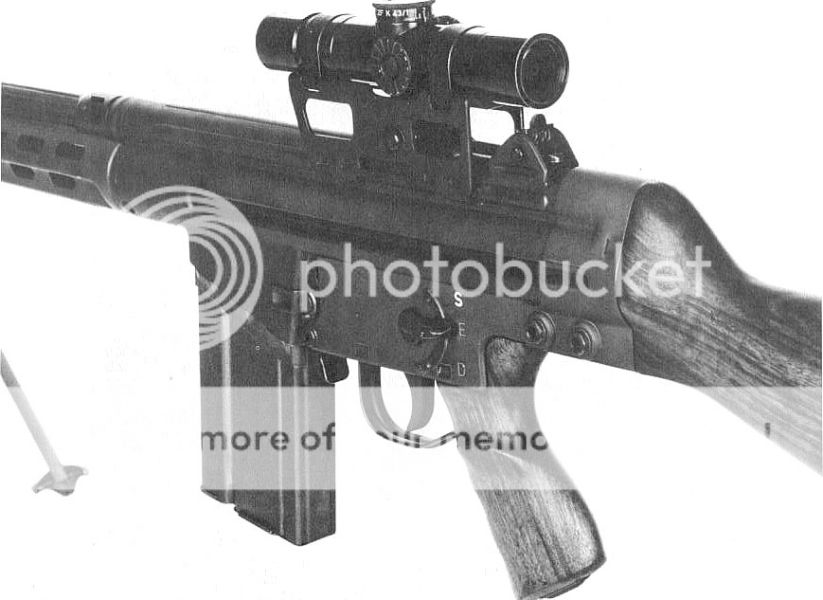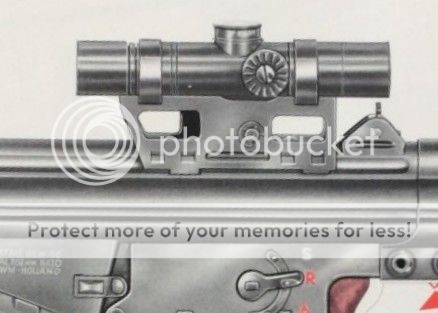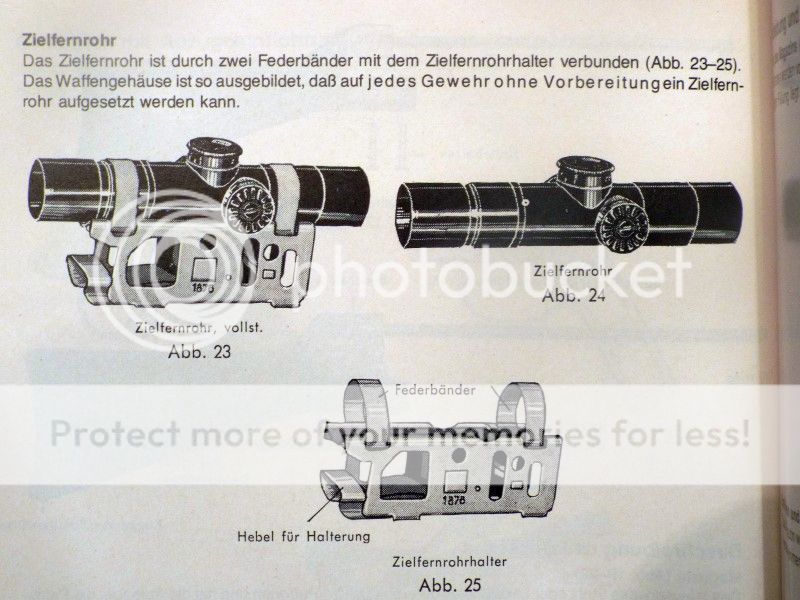
Early G3/CETME scope mount
21 - 40 of 40 Posts
Joined
·
11 Posts
That is amazing thank you. I would be especially interested in the production model mount with the DIAPI-D scope. If you cannot get permission to post the images, do you have a source I can lookup?@Madmax2000
Here’s what I have. Granted it’s from the Full Circle book (credit).
I do have some other photos of a production model mount with the DIAPI-D scope attached but waiting on permission to post them.
The fist one pictured in the book is listed as a prototype. The production model (second pic) has a solid cast throw lever unlike the one that appears to be stamped sheet metal.
View attachment 434972
View attachment 434973
View attachment 434974
Joined
·
11 Posts
Those images look great. I cannot express my gratitude enough. These are the only images of this scope setup anywhere on the internet.
It is interesting that they decided to go with a 2.5X DIAPI-D scope. The G1 had a 4X ZF4 Hensoldt scope that evolved from the WW2 era ZFK 43/1. Which later in turn evolved into the later G3 scopes. I would have expected them to use the 4X ZF4 from the G1.
 www.mdshooters.com
www.mdshooters.com
It is interesting that they decided to go with a 2.5X DIAPI-D scope. The G1 had a 4X ZF4 Hensoldt scope that evolved from the WW2 era ZFK 43/1. Which later in turn evolved into the later G3 scopes. I would have expected them to use the 4X ZF4 from the G1.
Band Mount Hensoldt ZF4 for G1 In Detail
All text and images that follow are copyright 2014 and are not to be used without the written permission of the author (me). I recently picked up one of the early band mounted ZF4s made by Hensoldt for the German G1 and I thought I'd do a short essay about this unit since there doesn't seem to...
Joined
·
11 Posts
I just found out something that blew my mind. This mount possibly with ground off locking tabs? Seems to have been offered as an option for the earliest wood furniture Stoner 63 rifles. This mount must have been commercially available in the states.The owner of those mounts and DIAPI scopes has asked the same question. We have yet to come up with a plausible answer why…
Joined
·
1,061 Posts
Very interesting, thanks for sharing your findings.I just found out something that blew my mind. This mount possibly with ground off locking tabs? Seems to have been offered as an option for the earliest wood furniture Stoner 63 rifles. This mount must have been commercially available in the states.
View attachment 438995 View attachment 438996
Joined
·
36 Posts
Can't believe I never noticed the scope from the Dutch print was a ZFK 43/1 and not a G1 Zf4 as I'd been working under the impression of. I think it's even the only scope of that family with the focusing knob on the left... How embarrassing.
It says something about the Diapi scope that they added such a significant amount of material for the bands to interface with compared to the ones I've seen available today. It looks like it may just be a sleeve? I wonder if you might be able to ask the owner if it's clear whether that material was part of the initial manufacturing process or a later addition, and if the total diameter corresponds to the ZF scopes. It may speak some to the intent of it.
A question about that early mount though, is the main tube see-through and in line with the iron sights? Looking at the photos of it being attached from Full Circle it appears to be too low for the G3 sight.
The mount seems utterly bizarre to the Stoner 63, basically none of it is being used. I think perhaps Cadillac Gage just had one of these sitting around and threw it on for a promotional shoot...
@21HK While looking up the ZFK 43/1 I came across this thread in which was posted some blueprints for early mounts. I did reach out to the user to see if they had anything more but received no response. https://www.k98kforum.com/threads/mount-for-rln-scope.14766/#post-95531
@Madmax2000 If you can share, what game are you developing? Seems like one I'd like to keep an eye out for.
It says something about the Diapi scope that they added such a significant amount of material for the bands to interface with compared to the ones I've seen available today. It looks like it may just be a sleeve? I wonder if you might be able to ask the owner if it's clear whether that material was part of the initial manufacturing process or a later addition, and if the total diameter corresponds to the ZF scopes. It may speak some to the intent of it.
A question about that early mount though, is the main tube see-through and in line with the iron sights? Looking at the photos of it being attached from Full Circle it appears to be too low for the G3 sight.
The mount seems utterly bizarre to the Stoner 63, basically none of it is being used. I think perhaps Cadillac Gage just had one of these sitting around and threw it on for a promotional shoot...
@21HK While looking up the ZFK 43/1 I came across this thread in which was posted some blueprints for early mounts. I did reach out to the user to see if they had anything more but received no response. https://www.k98kforum.com/threads/mount-for-rln-scope.14766/#post-95531
@Madmax2000 If you can share, what game are you developing? Seems like one I'd like to keep an eye out for.
Joined
·
1,061 Posts
Looking at another photo I have shows the sleeve off of the scope.
They were complete, meaning together/assembled, when he received them with the sleeve in place. This was a good 10-12 years ago. My guess is the mounts were for the ZF.
Who’s to say, maybe the early importers received a box of mounts and a box of scopes that didn’t fit together.
He disassembled the scopes for cleaning and sent me a good strap to use as a pattern to make new ones.
I have to agree with your theory about the HK mount on the Stoner.
Thanks for the link to the other prints. These early claw mounts on the early receivers that didn’t have scope tabs was probably a challenge. 🥴
![Image]()
They were complete, meaning together/assembled, when he received them with the sleeve in place. This was a good 10-12 years ago. My guess is the mounts were for the ZF.
Who’s to say, maybe the early importers received a box of mounts and a box of scopes that didn’t fit together.
He disassembled the scopes for cleaning and sent me a good strap to use as a pattern to make new ones.
I have to agree with your theory about the HK mount on the Stoner.
Thanks for the link to the other prints. These early claw mounts on the early receivers that didn’t have scope tabs was probably a challenge. 🥴
Joined
·
36 Posts
Interesting. Any indications as to how the Diapi maintains its position within the sleeve?
If you still have a strap or dimensions thereof I could compare their length to those of my G1 ZF4. I'm rather of a mind that these were intended for said scope, but set aside in lieu of the 'STANAG' mounting that appears to be in development already at the time with the prototype mount photo you posted from Full Circle. The hiccup in the theory of course being that I haven't any dates for when the revised 'STANAG' ZF scopes began production or entered service to corroborate.
Regarding those early early mounts... I'm just baffled that no one welded a dovetail to the thing and called it a day.
If you still have a strap or dimensions thereof I could compare their length to those of my G1 ZF4. I'm rather of a mind that these were intended for said scope, but set aside in lieu of the 'STANAG' mounting that appears to be in development already at the time with the prototype mount photo you posted from Full Circle. The hiccup in the theory of course being that I haven't any dates for when the revised 'STANAG' ZF scopes began production or entered service to corroborate.
Regarding those early early mounts... I'm just baffled that no one welded a dovetail to the thing and called it a day.
Joined
·
11 Posts
This mount could not have been earlier than 1961 or later than 1963 since it appears in the early Stoner 63 marketing material. It was likely around already in 1962 when the first batch of G3’s was imported.Interesting. Any indications as to how the Diapi maintains its position within the sleeve?
If you still have a strap or dimensions thereof I could compare their length to those of my G1 ZF4. I'm rather of a mind that these were intended for said scope, but set aside in lieu of the 'STANAG' mounting that appears to be in development already at the time with the prototype mount photo you posted from Full Circle. The hiccup in the theory of course being that I haven't any dates for when the revised 'STANAG' ZF scopes began production or entered service to corroborate.
Regarding those early early mounts... I'm just baffled that no one welded a dovetail to the thing and called it a day.
Rheinmetall also manufactured G3’s with slight differences compared to HK. I don’t think this was a Rheinmetall item since it was imported.
The revised mount with the screw-on scope was likely a few years later. The 1966 printing of the G3 manual shows both the later scope/mount and this mount with the 1959 Hensoldt scope. The later mount is shown on a separate page. There is a 1963 printing of the manual which I could not obtain which could help answer this question. Rifles with exceptional accuracy were issued with scopes from the factory. The later scope was issued along with the G3A3 from the factory as the G3A3 ZF possibly as early as 1964-66. I am not 100% sure about the introduction date of the G3A3 some say 1963 but are probably confusing it with the very similar G3A2 which was only produced for approximately one year and lacked a free floating barrel.
My guess is that this mount was available between 1962 and the G3A3 ZF introduction. It is possible this early mount was never issued and only existed as an accessory in the HK catalog.
Joined
·
11 Posts
Here are the pictures from the November 1966 manual. The old mount is shown with a G3a3 with the stepped a3 charging tube. The manual has better images of the G3a3 in other places.
![Image]()
![Image]()
![Image]()
The scope is connected to the scope holder by two screws.
The rifle housing is designed so that a scope can be mounted on any rifle without preparation. The scope then receives the corresponding weapon number.
![Image]()
![Image]()
The scope is connected to the scope holder by two screws.
The rifle housing is designed so that a scope can be mounted on any rifle without preparation. The scope then receives the corresponding weapon number.
Joined
·
1,061 Posts
@TheNowhereMan
I have no idea what the relationship is between the scope and sleeve. I never had them in my possession.
I still have a template I made.
It’s 8-1/16” in length (205mm)
@Madmax2000
Thanks for the additional info and pics.
![Image]()
I have no idea what the relationship is between the scope and sleeve. I never had them in my possession.
I still have a template I made.
It’s 8-1/16” in length (205mm)
@Madmax2000
Thanks for the additional info and pics.
Joined
·
11 Posts
Joined
·
1,061 Posts
I thought the images you posted looked familiar to the ‘61, I had to pull it out to have a look.Thanks for the 1961 manual. It looks like it has the same layout at the 1966 manual just the images were changed.
There is a lot of repetition of images/illustrations in these booklets.
Joined
·
11 Posts
Doing measurements in GIMP I came up with a diameter of 27mm as mounted with the DIAPI-D. Not sure if the mount had some range of adjustment probably not up to 30mm. 26mm, 26.5mm 27mm rings are all possible for period scopes. Someone else should do it and see what they come up with.
Edit: I Tried a different method comparing the ratio of the inside to outside tube and got a diameter of 26.33mm. 26mm diameter was more common post war.
Edit 2: The 1959 Hensoldt scope had a lens size diameter of 24mm and 27mm tube diameter.
Edit: I Tried a different method comparing the ratio of the inside to outside tube and got a diameter of 26.33mm. 26mm diameter was more common post war.
Edit 2: The 1959 Hensoldt scope had a lens size diameter of 24mm and 27mm tube diameter.
Joined
·
36 Posts
Here are some more examples of the Diapi: https://shootingglass.com/diapi-d/main.htm
Silly of me. I fixated on the Diapi and forgot about the knobless Hensoldt scope...
The more I look the more things I notice I've missed. Like the Diapi having shorter saddles and still having lopsided anchors to accommodate the increased size from the sleeve. Which in turn made me realize that the left side anchors for this mount are slotted/hooked in rather than screwed in, which is unique amongst all the strap mounts that I am aware of. Interestingly, this also makes the Gruppe.9 statement in the '66 manual correct for both the strap and screw mounts. Only two screws either way! Although the '61 clearly indicates this is not how they would describe the strapped system.
We can't really compare without a right side view of the Hensoldt, although we can see that the anchors are even in the photos and illustrations, but the right anchor on the Diapi being so far up, with what doesn't appear to be a made-to-purpose screw, really supports 21HK's aftermarket commercial theory. That would be uncharacteristically sloppy work for Hensoldt.
@Madmax2000 It also illustrates the only real adjustment available for this mounting system without swapping any parts- simply using a longer screw on the anchor. Although that alone is still generally insufficient, as a larger scope wont seat properly without replacing the saddle.
@21HK You have a little typo there, 250mm rather than 205.
I shouldn't think these are actually of any use without dimensions for the different saddles, but for interest here are the measurements I took:
1. Reproduction straps I have for a WWII ZF scope: 232mm
2. G1 ZF4: 194mm straps - The scope tube is 30mm (29.94)
3. Same pattern of mount as the G1 ZF4, but a smaller size produced by FN: 167mm straps - For tubes of 22mm (21.9)
Silly of me. I fixated on the Diapi and forgot about the knobless Hensoldt scope...
The more I look the more things I notice I've missed. Like the Diapi having shorter saddles and still having lopsided anchors to accommodate the increased size from the sleeve. Which in turn made me realize that the left side anchors for this mount are slotted/hooked in rather than screwed in, which is unique amongst all the strap mounts that I am aware of. Interestingly, this also makes the Gruppe.9 statement in the '66 manual correct for both the strap and screw mounts. Only two screws either way! Although the '61 clearly indicates this is not how they would describe the strapped system.
We can't really compare without a right side view of the Hensoldt, although we can see that the anchors are even in the photos and illustrations, but the right anchor on the Diapi being so far up, with what doesn't appear to be a made-to-purpose screw, really supports 21HK's aftermarket commercial theory. That would be uncharacteristically sloppy work for Hensoldt.
@Madmax2000 It also illustrates the only real adjustment available for this mounting system without swapping any parts- simply using a longer screw on the anchor. Although that alone is still generally insufficient, as a larger scope wont seat properly without replacing the saddle.
@21HK You have a little typo there, 250mm rather than 205.
I shouldn't think these are actually of any use without dimensions for the different saddles, but for interest here are the measurements I took:
1. Reproduction straps I have for a WWII ZF scope: 232mm
2. G1 ZF4: 194mm straps - The scope tube is 30mm (29.94)
3. Same pattern of mount as the G1 ZF4, but a smaller size produced by FN: 167mm straps - For tubes of 22mm (21.9)
Joined
·
11 Posts
I am quite sure this mount has a 27mm saddle for the 1959 Hensoldt scope. I did not see any information that the 1959 Hensoldt scope ever made it past the prototype stage. 27mm is not that common post-war. What likely happened was they had mounts for the 27mm 1959 Hensoldt scope. At some point before the Stoner 63 image, the adapter tube was added to adapt to the 22.225mm (7/8”) DIAPI-D scope. It could have been after-market or by HK.Here are some more examples of the Diapi: https://shootingglass.com/diapi-d/main.htm
Silly of me. I fixated on the Diapi and forgot about the knobless Hensoldt scope...
The more I look the more things I notice I've missed. Like the Diapi having shorter saddles and still having lopsided anchors to accommodate the increased size from the sleeve. Which in turn made me realize that the left side anchors for this mount are slotted/hooked in rather than screwed in, which is unique amongst all the strap mounts that I am aware of. Interestingly, this also makes the Gruppe.9 statement in the '66 manual correct for both the strap and screw mounts. Only two screws either way! Although the '61 clearly indicates this is not how they would describe the strapped system.
We can't really compare without a right side view of the Hensoldt, although we can see that the anchors are even in the photos and illustrations, but the right anchor on the Diapi being so far up, with what doesn't appear to be a made-to-purpose screw, really supports 21HK's aftermarket commercial theory. That would be uncharacteristically sloppy work for Hensoldt.
@Madmax2000 It also illustrates the only real adjustment available for this mounting system without swapping any parts- simply using a longer screw on the anchor. Although that alone is still generally insufficient, as a larger scope wont seat properly without replacing the saddle.
@21HK You have a little typo there, 250mm rather than 205.
I shouldn't think these are actually of any use without dimensions for the different saddles, but for interest here are the measurements I took:
1. Reproduction straps I have for a WWII ZF scope: 232mm
2. G1 ZF4: 194mm straps - The scope tube is 30mm (29.94)
3. Same pattern of mount as the G1 ZF4, but a smaller size produced by FN: 167mm straps - For tubes of 22mm (21.9)
Unless the 1959 Hensoldt scope actually went into production or some other 27mm scope was available, the post-war Kahles scopes are 26mm, this mount was likely just some extra prototype mounts that got sold on the commercial market.
Joined
·
36 Posts
Compare the thickness of the saddle to the diameter of the anchors in these two pictures. Just eyeballing it's clear the Hensoldt saddle is about twice as thick vertically as the saddle used for the Diapi, yet the Diapi's straps can not reach as far.I am quite sure this mount has a 27mm saddle for the 1959 Hensoldt scope. I did not see any information that the 1959 Hensoldt scope ever made it past the prototype stage. 27mm is not that common post-war. What likely happened was they had mounts for the 27mm 1959 Hensoldt scope. At some point before the Stoner 63 image, the adapter tube was added to adapt to the 22.225mm (7/8”) DIAPI-D scope. It could have been after-market or by HK.
Unless the 1959 Hensoldt scope actually went into production or some other 27mm scope was available, the post-war Kahles scopes are 26mm, this mount was likely just some extra prototype mounts that got sold on the commercial market.
Joined
·
11 Posts
The ring height has clearly been reduced for the mount with the DIAPI-D among other changes such as the release lever. The G3 manuals are fairly good at showing these small details and do show the updated release handle.Compare the thickness of the saddle to the diameter of the anchors in these two pictures. Just eyeballing it's clear the Hensoldt saddle is about twice as thick vertically as the saddle used for the Diapi, yet the Diapi's straps can not reach as far.
View attachment 441037
View attachment 441038
I did my measurements in two ways.
1: First by using the holes in the bands as a reference I measured the total exposed length of the band. I then reduced it by two times the estimated distance from the screw to the centerline of the scope measured. One side has a large band hole that is exposed which helped. This gave me half of the circumference and I then found the diameter.
2: I compared the inside of the adaptor tube to its outside diameter in pixels. Using the known diameter of the DIAPI-D I multiplied it by the aforementioned ratio. The image was burry and had perspective issues but not enough to create a huge error.
Clearly, when they reduced the ring height, they also reduced the band length. This would not affect my measurement techniques.
21 - 40 of 40 Posts
-
?
-
?
-
?
-
?
-
?
-
?
-
?
-
?
-
?
-
?
-
?
-
?
-
?
-
?
-
?
-
?
-
?
-
?
-
?
-
?
- posts
- 2M
- members
- 97K
- Since
- 2000
Actually created in 1999 (the original posts from the first database were lost), we are a forum dedicated to and laser-focused on Heckler & Koch firearms, Heckler & Koch accessories and the owners and enthusiasts that love them! Come join the discussion regarding HK pistols, long arms, NFA arms, HK accessories, HK history and trivia and more.
Explore Our Forums






